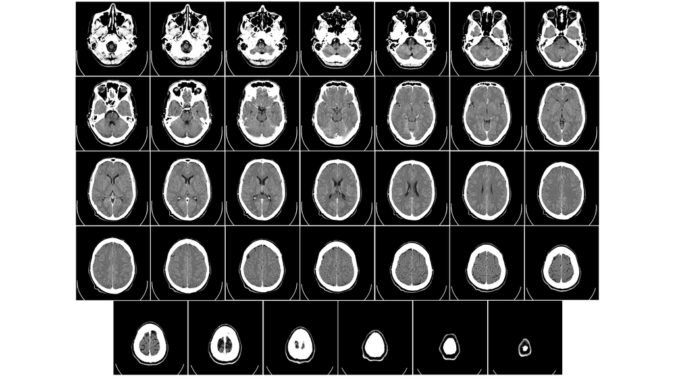
Last year, more than 80 million CT scans were performed in the United States. Countless others were done in other countries all around the world. It’s an extraordinarily useful diagnostic tool in modern medicine that has helped save lives or improve the health of patients with non-life threatening illnesses. Computed Tomography (CT scan), also called Computed Axial Tomography (CAT scan) is a technique whereby x-rays are passed through human tissue, typically an organ such as the brain. The CT machine generates x-rays on one side of the body and simultaneously detects them after they pass through the body. A CT scan is orders of magnitude better than an ordinary x-ray camera, however, because the CT machine revolves around the patient, taking numerous x-ray pictures in a wide range of angles. The density of the tissue the x-rays pass through is recorded at each angle. Density affects the x-ray signal strength, so denser material is a different shade than diffuse material. For example, bone is denser than brain matter. X-ray data collected during the CT scan is processed by a computer to create a multi-layer digital image of the organ examined. If this sounds extremely complex and brilliantly conceived, it is!
The man who concocted the idea also designed and built the first CT scanner: British engineer Godfrey Newbold Hounsfield (August 28, 1919 – August 12, 2004, aged 84). Growing up on a farm, the youngest of five children, Hounsfield was captivated by the various machinery and electrical devices used by his father. By some accounts he wasn’t a great student, while other sources say he excelled in mathematics and physics. A lifelong interest in Egyptian pyramids developed sometime during his childhood, centered around the discovery by archaeologists of hidden rooms inside the desert monuments. Hounsfield reasoned that it should be possible to detect other cloistered chambers by placing a cosmic wave detector at the lowest level of the pyramid and let energy from the stars reveal new hidden chambers, like an x-ray machine from the heavens. (In 2017, researchers used this method to discover an inaccessible chamber in the Great Pyramid of Giza.)
Apparently Hounsfield also held a fascination with flying and built a home-made glider, which he launched himself in from atop hay stacks. His interest in flight may be the reason he volunteered as a reservist with the RAF in the thirties before the Second World War began. The Royal Air Force schooled Hounsfield in electronics and assigned him to a radar unit. During the war he proved himself to be a highly skilled technician, going so far as modifying radar sets to allow Allied pilots to find their way home at night and in bad weather. Impressed, his commanding officer encouraged him to study Electrical Engineering after the war. With diploma in hand, Hounsfield found a job in 1949 with a company called Electric and Musical Industries, Limited (EMI), which put him to work on radar and guided weapon systems.
In the 1950’s, Hounsfield developed an interest in computers, becoming leader of the EMI team that by 1958 had built Britian’s most powerful and advanced computer. EMI enjoyed successful sales of their mainframe for a few years, but competition from bigger competitors in the 1960s bittered the company’s taste for that market and they got out. After all, one of EMI’s business units was making a healthy profit selling Beatle’s records, so losing money on computers was simply unnattractive. That left Hounsfield with nothing to do. Placed on involuntary leave, he took his family on holiday in the countryside while he pondered what he could do to remain employed with EMI. A chance conversation provided the answer. A physician he’d met told him about the difficulty of getting a good x-ray image of the brain. Being soft tissue, the technology of the day could not make out any useful details. Hounsfield immediately connected the doctor’s problem of seeing inside the skull with his own idea of seeing inside a pyramid. The rest is history. Hounsfield built the first CT scanner machine, which performed the very first CT scan on October 1, 1971. This achievement led to the award of the Nobel Prize for Physiology or Medicine in 1979. To top it off, he was knighted by the Queen in 1981. Not bad work.
Question Of The Night: Do you have a green thumb or a talent in some other area of expertise?
